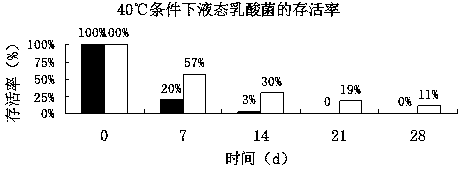A kind of lactic acid bacteria preservative that improves the survival rate of liquid lactic acid bacteria at normal temperature and its application
A technology of lactic acid bacteria and preservatives, applied in the direction of preservation of microorganisms, methods based on microorganisms, microorganisms, etc., can solve the problem of the decline of viable bacteria, achieve long-term storage, delay the time of decay, and improve the survival rate
- Summary
- Abstract
- Description
- Claims
- Application Information
AI Technical Summary
Problems solved by technology
Method used
Image
Examples
Embodiment 1
[0030] The liquid medium of this embodiment is used as a control group, and its liquid medium formula is taken by weight: 0.1 part of peptone; 0.1 part of yeast extract powder; 5 parts of white granulated sugar; 2 parts of glucose; 1 part of skimmed milk powder; part; 0.03 part of manganese sulfate heptahydrate; 2 parts of corn steep liquor dry powder; NaH 2 PO 4 0.03 parts; 0.3 parts of sodium citrate; 0.25 parts of citric acid; 0.1 parts of sodium acetate; 0.1 parts of Tween 80; add 86 parts of purified water. 115°C, autoclave for 20 minutes.
[0031] Choose 3 kinds of lactic acid bacteria, namely: Lactobacillus acidophilus ( Lactobacillus acidophilus ), Lactobacillus casei ( Lactobacillus casei ), Lactobacillus plantarum ( lactobacillus plantarum ). Add 3 parts of mixed lactic acid bacteria seed solution to the above liquid medium, culture at 37°C for 36 hours, and aseptically dispense. At the same time, the number of lactic acid bacteria colonies was measured as ...
Embodiment 2
[0036] The formula of the liquid medium in this embodiment is weighed in parts by weight: 0.1 part of peptone; 0.1 part of yeast extract powder; 5 parts of white sugar; 2 parts of glucose; 1 part of milk powder; 4 parts of cream; 1 part of linoleic acid; resistant dextrin 0.05 parts; 0.06 parts of magnesium sulfate heptahydrate; 0.03 parts of manganese sulfate heptahydrate; 2 parts of corn steep liquor dry powder; sodium carboxymethyl cellulose: sodium alginate: guar gum: xanthan gum=2:2:1:2 0.2 parts; NaH2 PO 4 0.03 parts; 0.3 parts of sodium citrate; 0.25 parts of citric acid; 0.1 parts of sodium acetate; 0.1 parts of lecithin; 115°C, autoclave for 20 minutes. Adjust the pH value of the culture solution to 3.5 to avoid the sedimentation point of most of the peptone and protein, so that the nutrients can be fully utilized.
[0037] Sodium carboxymethyl cellulose: sodium alginate: guar gum: xanthan gum is mixed according to the ratio of 2:2:1:2 to form 0.2 parts by weight; ...
Embodiment 3
[0051] The liquid lactic acid bacteria that embodiment 1 and embodiment 2 obtain (3 * 10 9 cfu / ml) for animal experiments to observe the effects of two liquid lactic acid bacteria on the growth performance of white-feathered broilers. Both liquid lactic acid bacteria were placed at room temperature of 25°C, and white feather broiler chickens were given drinking water from the age of 4 days, and the addition amount was 1000ml / ton of water. Finally, the difference in the growth performance of white feather broiler chickens between the lactic acid bacteria cultured in the two media was observed.
PUM
 Login to View More
Login to View More Abstract
Description
Claims
Application Information
 Login to View More
Login to View More - R&D
- Intellectual Property
- Life Sciences
- Materials
- Tech Scout
- Unparalleled Data Quality
- Higher Quality Content
- 60% Fewer Hallucinations
Browse by: Latest US Patents, China's latest patents, Technical Efficacy Thesaurus, Application Domain, Technology Topic, Popular Technical Reports.
© 2025 PatSnap. All rights reserved.Legal|Privacy policy|Modern Slavery Act Transparency Statement|Sitemap|About US| Contact US: help@patsnap.com

